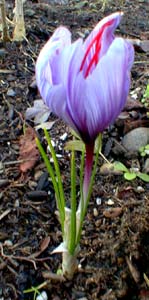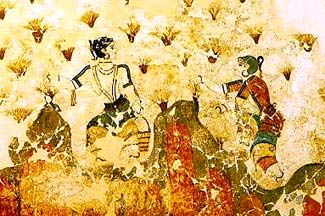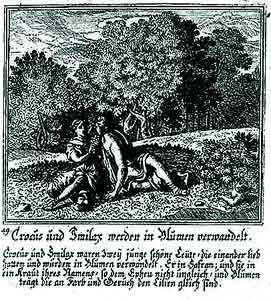
Ancient Cultic Associations
of Saffron Crocus
"Knowest thou
What solemn shores of crocus-coloured light,
Reared by the sunset in its realm of change,
Will mock the dream-lost isles that sirens ward?"
-Clark Ashton Smith
Part I:
The Crocus as Fertility Daemon to the Mother Goddess
Elizabeth Wayland Barber in Women's Work: The First 20,000 Years (1994) noted that yellow was the color of women's garments in the ancient world. Saffron was used to dye the garments of women of high status, such as priestesses, in shades from pale yellow to deep orange-red.The best-known Minoan Snake-goddess figurine shows her wearing yellow garments. An additional pottery representation of an apron-like garment found at Knossos was decorated with images of crocus blossoms. Actual saffron crocuses worn at the girdle were believed to relieve menstrual cramps; & saffron spice was used medicinally for this very purpose. It was also believed to induce a higher level of potency in men who took saffron.
Saffron crocuses originated as sacred flowers of Crete. It early made its way as far into the east as India, carried along ancient trade routes. In the East, right down to the present day, saffron robes are associated with Buddhist & Hindu divinities & priests, & Buddhist monks & nuns, & with women's garments generally.
 A Minoan fresco found at Thera in 1973 shows women dressed in yellow & orange-red, gathering saffron stigmas from crocuses, & offering them to a seated goddess or high priestess. Part of this fresco is shown on the present page. This was found decorating a lustration chamber where cultic activity surrounded menstruation, childbirth, & young girls coming of age ceremonies.
A Minoan fresco found at Thera in 1973 shows women dressed in yellow & orange-red, gathering saffron stigmas from crocuses, & offering them to a seated goddess or high priestess. Part of this fresco is shown on the present page. This was found decorating a lustration chamber where cultic activity surrounded menstruation, childbirth, & young girls coming of age ceremonies.The Mother Goddess frequently had a subsidiary brother, son, or consort who symbolized Her fertility. He was generally associated with some plant that has a season, then dies away or is harvested, then returns the next year. Hence Aphrodite loved the dying & reborn Adonis who, when slain by a boar, gave rise to anemone flowers everywhere his blood dripped on the ground. Adonis became a seasonal fertility daemon who when dormant dwelt in Hades as a companion to Peresephone, but in spring returned to the land of the living temporarily to be again with Aphrodite. So too Anath's brother Baal, & Paghat's brother Aqhat, were Semitic grain-gods whose death was followed by their resurrection as millet.
It is not surprising then that there is a fertility daemon named Krokos, a Spartan youth whose myth is not well preserved, but has many parallels. He was, like many of these fertility daemons, inclined to homosexuality. As Attis was the catamite of Apollo, Narcissus loved his own reflection, & Hyacinthos was beloved of Zeus & Apollo, so too Krokos was a flower-boy who became the lover of androgynous Hermes. But Krokos was mortal & by their rough play together, Hermes accidentally gave his beloved a mortal wound, some said with a discus, others with a quoit. Wherever the blood of Krokos fell, a saffron flower grew, the three red style retained the color of his blood.
Much the same myth is told of Apollo accidentally killing his beloved Hyacinthos, when his discus was blown off course by the jealous Wind-god Zephyros. The recurring homosexuality of these flower-boys likely began with Cybele's companion Attis, who was not Cybele's lover in any physical sense because he was a gallus, self-castrated, & violets grew from the ground in the place where he tossed his bloody member. Dionysios, too, was a gallus with homosexual liasons, associated with grape ivy. That these myths reflect some only half-remembered cultic associations dating to Minoan high culture is undeniable, & the name of Krokos predates the Greek language, having no Greek root.
This mythology of the castrated hence sterile flower-boy as sexless companion to the Mother Goddess & passive lover of active male gods has an interesting parallel to the saffron crocus in particular, in that this crocus is itself sterile & cannot produce seeds.
By another myth, the saffron crocus arose from the blood of crucified Prometheus, who was, like saffron-colored Eos, an illuminator of mortals. The Promethean herb was the toxic autumn crocus Colchicum autumnale sometimes called "meadow saffron." Though it bares no spice, it does grow native in the Caucasus where Prometheus was crucified. Still, throughout most of the Greek world any reference to a sacred crocus had inevitably to be saffron, & when this assumption was made, it was further believed that the trio of red stigmas were trickles of actual ichor, blood that had oozed from a Titan's vulture-pierced liver. From thes stigmas Medea manufactured "the Promethean salve" which when smeared on Jason's body while praying to Hekate, rendered him invulnerable.
Some supposed that humanity itself was manufactured from clay wetted with this same ichor, & that all of humanity's agonies were the fault of Prometheus who (Dionysios worshippers proposed) should have given man a mind-expanding vintage, not destructive fire. It was further believed that whenever & wherever the stigmas were gathered, Prometheus suffered great agonies, & the association with the crocus & death-agonies is common to all its mythology.
It is believed that saffron crocus originally grew nowhere but on the isle of Crete as a triploid sport of a Greek species Crocus cartwrightianus. The triploid crocus is sterile & it reproduces only by offsets on the corms. It cannot spread naturally, but declines if not dug up ever other year or so & the corms divided. That it even so spread throughout Europe & India & eventually into China was due to ancient routes of IndoEuropean traders. One must suppose that the priestesses who grew it attempted to keep cultivation methods secret & to sell only the spice, not the corms, but such secrets are easily penetrated, & even if the trade in the corms were unofficial, the black market was inevitable for something that so perfectly blended monetary & religious benefits. The saffron dye & spice obtained from the three female style of each bloom had a value greater than jewels or precious metals, causing it to become the most widespread cultivar in the ancient world, from at least millenium before the rise of Athens.
The myth type of Krokos & Hermes would seem to have been closely related to Copper Age or Bronze Age agricultural practices, including grape, grain, & flower cultivation. The precise importance of the fertility daemon Krokos is not as well preserved as that of Hyacinthos, Dionysios, or Attis, but this seems not to be because he was of less significance. Indeed, the opposite may be true, & he was of such intense importance that his meaning & nature were among the most guarded secrets of the Eleusian Mysteries. Persephone had been gathering purple saffron crocuses when she was taken into the underworld, & she returned with yellow spring crocuses bursting forth around her feet; saffron crocuses, & indeed crocuses of all kinds, were the commonest of all flower-offerings at Her shrines, & the Krokos of the Eleusian Mysteries certainly must have addressed this association.
When Demeter first saw spring's bright yellow crocuses, she was angered, demanding who had disobeyed her edict that nothing flourishes until Persephone was restored to her side. The crocuses themselves replied, "But the Maid is coming!" Demeter in a dither of excitement dawned a mantle made of white crocuses in order to greet her returning daughter, who rose out of the ground in the circle of sunny yellow blooms. These pure yellow crocuses were probably the natural wild Golden Crocus (C. chrysanthus) which is native to Greece, Galacia, & Macedonia. It blooms while snow is still upon the ground, before the start of spring, hence would have provided the first evidence of Persephone's restoration. Demeter's mantle of white crocuses could have been a mixture of Autumn & Spring crocuses. At least three white-blooming autumn species grow on the Pelopponesus. Among spring species, many have always had white forms. All crocuses were sacred to Demeter & Persephone, with the Saffron symbolic of the death of the world, the white-crocused mantle being snow upon Demeter's sad shoulders, & spring's Golden Crocus representing the joy of Demeter. Of these, however, only the deathly Saffron Crocus possessed the sacred spice.
During the Eleusian Mysteries, initiates by the thousands honored the godling Krokos as an ancestral divinity of some consequence, first to have dwelt among the brackish rivers & inlets of the Rhiti district near Athens. There was a guarded ceremony which was known as the krokosis, the importance of which was never revealed to outsiders, though practiced into the Christian era.
All that is today known of the mysteries of Krokos is that everyone initiated in the krokosis ceremony would receive a woolen wrist-band called a kroke which was dyed with saffron, & bound to the wrist by priests claiming to be the linear descendants of Krokos. This association with Demeter would seem to identify him as a byform of Dionysos & Attis as fertility daemon to Rhea or Demeter or Cybele.
 Yet another version of the myth of Krokos makes him either the lover or the rejected suitor of the nymph Smilax, whose name is that of a vining sarsparilla herb, though her name was also associated with the vining scammony that produced a resin prized by sorcerers. Krokos & Smilax are shown at the right in a Rennaisance engraving for The Metamorphosis.
Yet another version of the myth of Krokos makes him either the lover or the rejected suitor of the nymph Smilax, whose name is that of a vining sarsparilla herb, though her name was also associated with the vining scammony that produced a resin prized by sorcerers. Krokos & Smilax are shown at the right in a Rennaisance engraving for The Metamorphosis.Contradictory fagments of a largely lost myth cannot be harmonized. Krokos was said to have failed to notice the advances of Smilax, so involved was he in his obsession for the hunt. As a Spartan, it was typical for such a youth to prefer the company of the camp over that of any woman, so to that extent this legend would serve as prelude to the older tale of his having been a lover of Hermes. Smilax, like Echo who could not get the attention of Narcissus, wasted away. When Aphrodite found her, the Goddess transformed the tragic nymph into the greenbiar, its flowers having the scent of carrion & its berries are black as night, to this day encountered vining amidst ruins on Aphrodite's first home, Cypros. Aphrodite furthermore petitioned Artemis to track down the cruelly indifferent hunter, who in consequence was transformed.
Alternatively, Krokos was witness to the death of his beloved Smilax, & the gods pitying his grief turned him into the saffron crocus so that he might live forever, & Smilax's corpse was turned into an evergreen yew tree to grow nearby. But in the most repeated version, it was Krokos who was rejected by an indifferent Smilax, thus it was he that wasted away, finally becoming a crocus, even as Narcissus wasted away for love of a reflexion which he mistook for an unreachable maiden. At the moment of Smilax's spurned lover's transformation, she was simultaneously turned into the greenbriar sarsparilla vine.
It is impossible to say which version could have been the original, as surviving fragments are literary inventions playing off now-forgotten fertility, medicinal, & cultic systems that may or may not have featured a hunter or shepherd as fertility daemon named Krokos, & an indifferent or adoring nymph of darkness named Smilax. But either way, the ancient values & meanings assigned to the plants themselves certainly inspired the stories.
The smilax is now known to contain steroidal saponins that might actually heighten female sexual desire, much as would an overabundance of testosterone in women. This is exactly what saffron spice was believed to do as well, saffron being the source of the sexual prowess of Priapus for example, & known even to have inspired Eos to ravage mortal kings. Smilax as an herb of women's sexual arousal would explain her association with Black Aphrodite. There's an implication that Smilax could thus have been the rejected aggressor in an unusually heightened state of arousal, so was the heartbroken to be ignored. As a night-nymph whose herb was one of the four most sacred to Hekate (the other three being black poppies, monkshoods, & mandrakes), she could never induce Krokos to awaken, given that a saffron crocus keeps its petals closed at night.
The version in which they were mutual lovers whom death came between may have one sustaining piece of evidence in its favor. Since herbal smilax was used in antiquity to concoct a treatment for venereal diseases, this makes one wonder if Krokos & Smilax weren't mutually lusty lovers (being both of them aphrodisiacs) who came to unhappy ends merely for spreading the clap. Plague divinities both cure & cause illnesses, so we can certainly see why it was that carrion-scented Smilax, despite that she was fair of face, was a daughter of Night rather than of some pleasanter divinity. In a later chapter of this monograph I will discuss the Keres, a sisterhood born of Nyx & which among other attributes were bringers of plague; their leader, Ker, was a diminishedform of Kar, an All-mother of Crete with rule of Life & Death, & to whom the saffron crocus was most sacred. Other than Ker, the Keres are never named, other than when it is noted that their names were plagues; it is not impossible that Smilax was one of Ker's sisterhood.
Ovid compares Krokos to Hyacinthos for myth type, & alludes to the story of Krokos & Smilax in the same breath with the Curetes, about whom also much will be said in Part III of this monograph, as the Curetes or Corybantes are caught up in the signal Cretan myth of sacrificial infant Zeus, who on Crete was said to have been made of saffron. Ancient mythologies are notorious for marking their own time-lines illogically, but if Krokos had to become a flower before the birth of Zeus, then he is older than Hermes & all the Olympians, but not necessarily any older than Smilax a daughter of a Titaness.
The flowering Smilax vine was worn by Maenads while in ecstastic, crazed, orgiastic, violent night-long rituals to honor Dionysios. But no one else would ever wear a garland of smilax, which symbolized Death & Misfortune, & especially the ill luck of lovers. Smilax as Herb was sacred to those punishers of matricides called the Erinyes, Eumenides, or Furies, themselves born of the blood-spatterings of Uranos's castration falling upon their mother Gaia, though many others said the Erinyes, like Smilax herself, were born of Nyx. The nymph Smilax may have been if not one of the Keres, then one of the Erinyes, with whom they at least associated as punishers of humanity. The Erinyes were numbered three only after Euripedes suggested it; some would have numbered them as fifty-five dismal daughters of Nyx, whose offspring were enemies of Eos & fled each morning before the stinging arrows of the Saffron Mother.
The saffron spice became best identified with Eos or Aurora in classical antiquity, but the flower itself belonged formost to the Furies, & to Demeter & Persephone or Black Aphrodite.
Continue to:
Part II:
The Crocus Mother:
Eos, Aurora, Ushas, Marici, or Anath